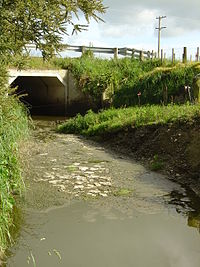
Photo from wikipedia
ABSTRACT A large population living in suburban and rural areas in the world uses septic systems, also called onsite wastewater treatment systems, to dispose of household wastewater. In a conventional… Click to show full abstract
ABSTRACT A large population living in suburban and rural areas in the world uses septic systems, also called onsite wastewater treatment systems, to dispose of household wastewater. In a conventional septic system, the wastewater flows from a household to a septic tank, where solids settle and a clarified effluent is produced. This effluent is dispersed into the soil for further treatment and can be a potential source of various contaminants such as nutrients, pathogens, and a new class of compounds known as trace organic chemicals (TOrCs) in shallow groundwater and surface waters. We review the current state of the science on the fate and transport of three groups of contaminants—nutrients (nitrogen, phosphorus), pathogens, and TOrCs—and water quality impacts associated with these contaminants in conventional septic systems. We also discuss alternative technologies that may be employed when site conditions or environmental needs preclude the use of conventional septic systems.
Journal Title: Critical Reviews in Environmental Science and Technology
Year Published: 2017
Link to full text (if available)
Share on Social Media: Sign Up to like & get
recommendations!